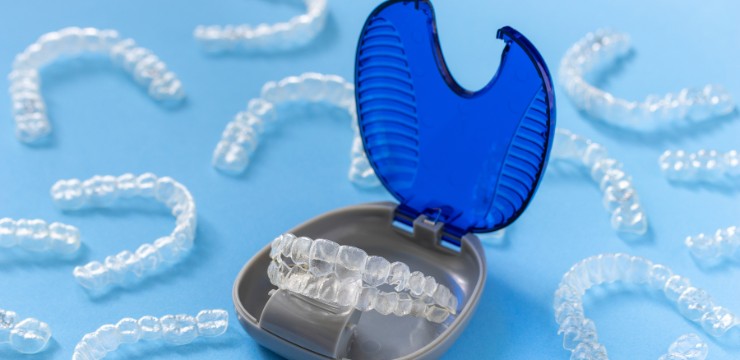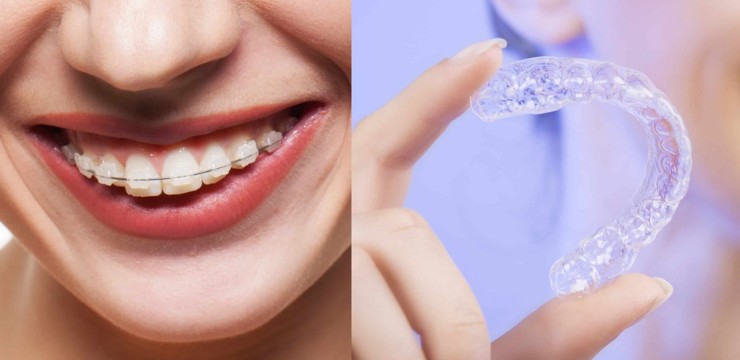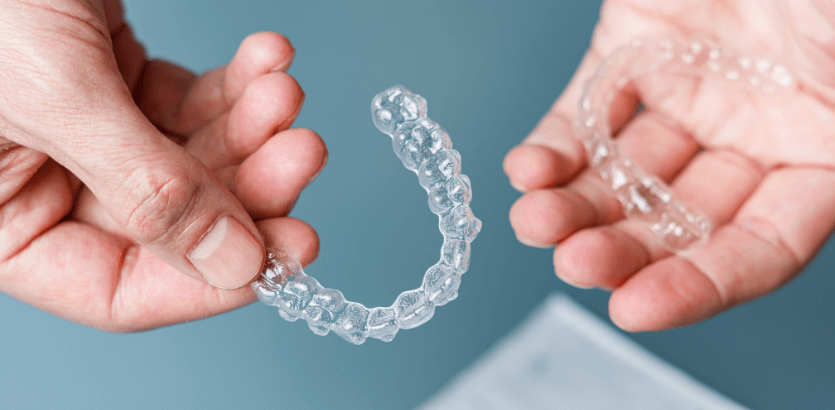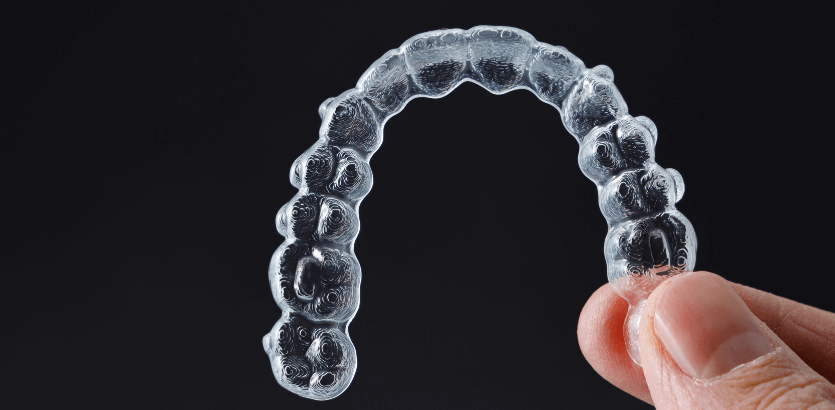
Invisalign or Clear Aligners has reshaped the domain of orthodontics, providing a discreet and convenient alternative to traditional braces. Let’s dive into the world of Invisalign and explore how this innovative treatment works.
What is Invisalign?
Invisalign or Clear Aligner is a modern orthodontic treatment that uses clear, removable aligners to straighten teeth. These custom-made aligners are crafted specifically for each patient, gradually shifting their teeth into the desired position over time.
History of Invisalign
Birth of an Idea (Mid-1990s)
The story of Invisalign starts with Zia Chishti, a Stanford student. While undergoing traditional orthodontic treatment with braces, Chishti noticed the role of his retainer in maintaining tooth position. This sparked the idea: could a series of clear, removable aligners achieve the same results as braces?
Development and Launch (1997-2000)
Chishti teamed up with Kelsey Wirth and other tech-savvy individuals to form Align Technology in 1997. They focused on developing the Invisalign system, leveraging computer-aided design and 3D printing to create customized aligner trays. Align received FDA approval for Invisalign in 1998, and the product officially hit the market in 2000.
Early Growth and Recognition (2000-2005)
The early 2000s saw steady growth for Invisalign. Patients were drawn to the system’s clear appearance and removable nature, offering a more discreet and comfortable alternative to braces. Align Technology’s innovative approach earned awards for design and rapid growth. The company achieved profitability in 2003 and continued expanding its reach.
Expansion and Innovation (2005-Present)
In 2005, Align Technology entered the Japanese market and acquired an orthodontics firm to strengthen its presence in the dental field. They also introduced the Invisalign Express option for less complex cases. The focus on technological advancements continued with the acquisition of Cadent in 2011, bringing intraoral scanning and 3D imaging capabilities to the table.
Today, Invisalign is a widely recognized brand, with millions of patients choosing it for their orthodontic treatment. Align Technology consistently refines the system, making it a more effective and accessible option for achieving a straighter smile.
Benefits of Invisalign
- Discreet Appearance: Clear Aligners offers a discreet solution for orthodontic treatment, as the clear aligners are nearly invisible, enabling patients to undergo treatment without drawing attention to their teeth.
- Enhanced Comfort: Unlike conventional braces, Clear Aligners are smooth and comfortable, minimizing irritation to the gums and cheeks throughout the treatment process.
- Convenient Removal: The flexibility to remove the aligners for eating, brushing, and special occasions adds to the convenience of Invisalign, allowing patients to maintain their oral hygiene and enjoy their favorite foods without restrictions.
How Invisalign Works
Initial Consultation and Treatment Plan
The journey with Invisalign begins with a consultation with an orthodontist who will assess your teeth and create a customized treatment plan. This plan includes the precise movements your teeth will undergo during each stage of treatment.
Customized Aligners
Once the treatment plan is established, a series of custom aligners are created using advanced 3D imaging technology. These aligners are worn for approximately 20-22 hours a day, with each set gradually shifting the teeth into the desired position.
Progress Monitoring and Adjustments
Regular check-ups with your orthodontist will ensure that your treatment is progressing as planned. Adjustments to the treatment plan may be made as needed to achieve optimal results.
Comparison with Traditional Braces

Comfort and Convenience
Clear Aligners offers superior comfort compared to traditional braces, as the aligners are smooth and do not cause irritation to the mouth. Additionally, the ability to remove the aligners for eating and oral hygiene makes it a convenient option for many.
Aesthetics and Discreteness
The clear aligners of Invisalign provide a subtle treatment option, unlike traditional braces which are more visible. This discreteness allows patients to undergo orthodontic treatment without feeling self-conscious about their appearance.
Treatment Duration and Effectiveness
While treatment duration varies depending on individual cases, Invisalign typically offers faster results compared to traditional braces. The effectiveness of Invisalign in correcting various orthodontic issues has made it a popular choice among patients of all ages.
Maintaining Oral Health with Invisalign
Proper Cleaning and Care of Aligners
To ensure the effectiveness of Invisalign treatment, it is essential to maintain proper cleaning and care of the aligners. Regularly rinsing the aligners and brushing them gently with a toothbrush will help keep them clean and clear.
Impact on Oral Hygiene
Clear Aligners allows for better oral hygiene compared to traditional braces, as the aligners can be removed for brushing and flossing. This reduces the risk of plaque buildup and tooth decay during treatment.
Avoiding Staining and Discoloration
To prevent staining or discoloration of the aligners, it is important to avoid consuming colored beverages such as coffee, tea, or red wine while wearing them. Proper care will help maintain the clarity of the aligners throughout treatment.
Invisalign Treatment Aftercare
Post-Treatment Retainers
After completing the Invisalign treatment, post-treatment retainers may be provided to maintain the straightened alignment of the teeth. But these retainers should be worn as directed by the orthodontist to prevent any shifting of the teeth.
Follow-Up Appointments
Regular follow-up appointments with the orthodontist are essential to ensure the long-term success of the Invisalign treatment. These appointments allow for monitoring of the teeth alignment and adjustments as needed.
Long-Term Smile Maintenance
Maintaining good oral hygiene practices and wearing post-treatment retainers as recommended will help preserve the results achieved with Invisalign. Thus keeping up with dental check-ups and cleanings will support the long-term health and appearance of your smile.
Recap of Invisalign Treatment Process
Clear Aligners offers a comfortable, discreet, and effective way to straighten teeth through custom-made aligners. Following the treatment plan, maintaining good oral hygiene, and attending follow-up appointments are key to successful results.
Final Thoughts and Recommendations
Invisalign is a modern orthodontic solution that combines convenience, comfort, and effectiveness. So, if you are considering Clear Aligners in Newton KS, Newton Dental Studio is the go-to choice for you. Consult with our orthodontist to determine if Clear Aligners is suitable for your specific needs.
Remember, a straighter smile is just a few aligners away with Invisalign!
Common Questions about Invisalign
Invisalign is not suitable for all orthodontic issues. Invisalign is typically used for mild to moderate crowding, spacing, and misalignment of teeth. Also if you have complex orthodontic issues, traditional braces might be a more suitable option. It’s always best to consult with a dentist or orthodontist to determine if Clear Aligners is right for you.
The recommended wear time for Invisalign aligners is typically 20-22 hours per day. This ensures consistent pressure is applied to move your teeth into the desired position. Your dentist or orthodontist will provide specific instructions on how often to change your aligners, which is usually every one to two weeks.
In some cases, wearing Invisalign aligners may cause slight lisping or other minor speech impediments during the initial adjustment period. This usually resolves within a few days or weeks as your tongue gets accustomed to the aligners. If you experience persistent speech problems, consult your dentist or orthodontist for guidance.


